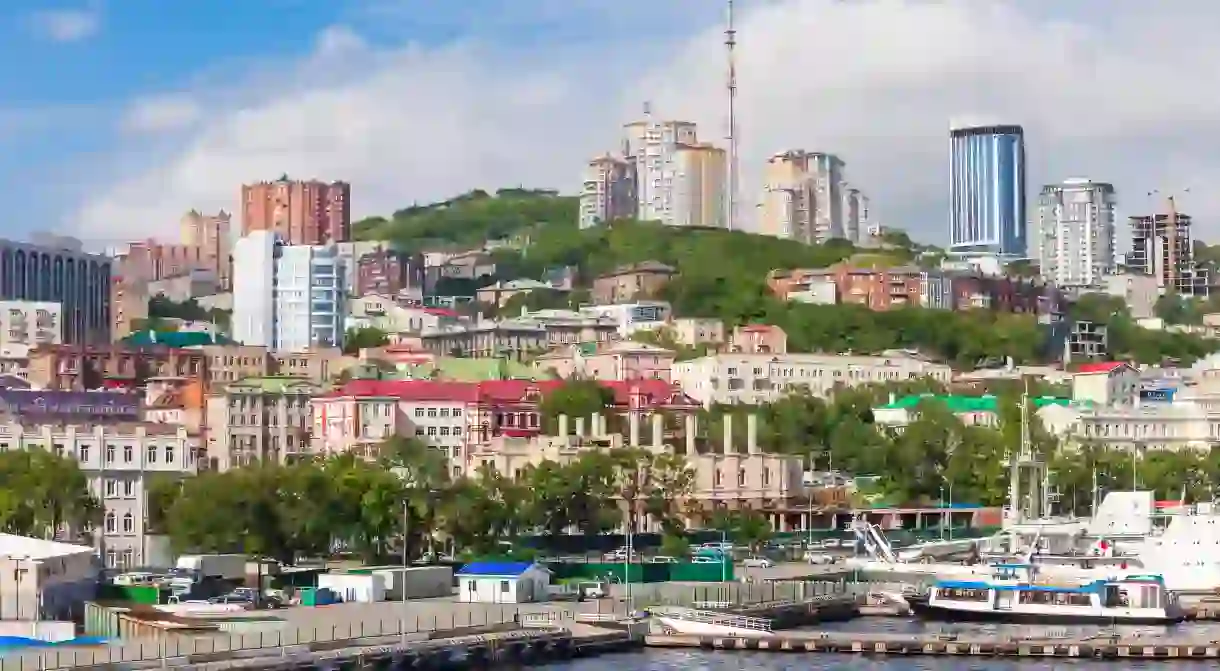The Top Things to Do and See in Vladivostok

Vladivostok has a unique, remote location in the Russian Federation: you can fly to Tokyo in just under three hours, but Moscow is nearly nine hours away by plane. Once known as the Wild East due to its reputation as a mafia hub, this port on the Sea of Japan now boasts attractions like the Zarya Centre for Contemporary Art and the S-56 Submarine Museum. Popular with international business travellers as well as those disembarking the Trans-Siberian Railway – which terminates here – Vladivostok has excellent opera, funky modern art, delicious food and a fascinating history. Here are the top things to do in the city.
Did you know – Culture Trip now does bookable, small-group trips? Pick from authentic, immersive Epic Trips, compact and action-packed Mini Trips and sparkling, expansive Sailing Trips.
Visit the Russian Opera House
Opera House, Theater

All steel, glass and sharp angles, the Russian Opera House turns heads in Vladivostok. Built for the Asia-Pacific Economic Cooperation Summit in 2012, it’s essentially a cube within a cube with glass walls. Step inside and prepare to be wowed: the venue has three stages – the grand hall, the small stage, and the summer stage, open from late spring until early autumn. Visit the most modern theatre in the Far East and enjoy its culture with old opera, ballet classics or breathtaking symphonies.
Try traditional food at Lozhki Ploshki
Restaurant, Russian, $

Escape the bitter outdoors in this local favourite serving classic Russian dishes: beetroot-rich borscht, homemade pelmeni dumplings in chicken-and-veg-laden soup, or varenyky (potato- and fried-onion-stuffed Ukranian dumplings). The basement setting makes a great place to idle, channelling industrial and rustic styles with exposed pipes, dangling wooden utensils and hanging baskets. Finish with piping-hot tea from a traditional samovar.
Tour the Fish Market
Market, Russian

The best pescatarian supplies in the city are sold at Sportivnaya Market, the largest market in Vladivostok and a long-standing favourite among locals. You can often buy the freshest produce straight from the people who netted the catch, and the fish and shellfish here are cooked there and then. Order up plenty of Kamchatka crabs, king prawns or small crayfish, and savour your bounty immediately on benches overlooking the waterfront. Once you’re sated, explore further – this may be a food market, but you’ll find everything from CDs and DVDs to kitchenware, clothes and toys.
Ride the Funicular
Amusement Park

Almost 60 years old, Vladivostok’s time-honoured transport novelty is still attracting crowds. It was built in 1962, when then-President Nikita Khrushchev, returning from a visit to the USA, recognised Vladivostok’s potential as the San Francisco of the USSR. The only one of its kind in Russia apart from a lesser version in Sochi, the funicular is actually a vital public service – although if you’re here as a tourist you won’t regret hopping aboard. The ride isn’t very long, but it’s cheap and passes through beautiful scenery. At the top you disembark right beside the main viewing platform on Eagle’s Nest Hill, which gives a mesmerising view.
Ascend Eagle’s Nest Hill
Natural Feature

A high point in downtown Vladivostok, Eagle’s Nest Hill rolls out the finest, most jaw-dropping urban panoramas. The geographical center of the city, it’s actually an extinct volcano, part of the Sikhote-Alin Mountain range, and sprouts a distinctive television tower and radio-transmitting centre. You can take the funicular or hike up the hill – there are about 370 steps, known locally as the health stairs – but either way the views of Vladivostok are utterly captivating, out over the glinting Golden Horn (Zolotoy Rog) Bay and the Sea of Japan.
Steam in a Russian bath at Banya More
Architectural Landmark

An authentic Russian banya session is invigorating and unforgettable. At Banya More, there are timber sauna cabins of varying sizes right on the beach. The extremes of temperature is what makes the Russian steam bath experience unique – furnace heat to get you sweating, transposed with ice cold to give your heart a kick start. Best of all is the gentle, aromatic beating delivered by the staff, using bunches of eucalyptus, birch and oak, which secrete aromatic oils.
Explore Zarya Centre for Contemporary Art
Theater

Since opening in August 2013, Zarya Centre for Contemporary Art has served as a space where people can interact with art in any way they like, including participating creatively. Contained within a converted factory loft, CCA Zarya encourages you to get involved in cinematography, theatre, literature, art, design and architecture, music and new media. Everyone is welcome – visitors to Vladivostok included – and lectures on various topics are conducted on a regular basis as part of an educational programme.
Enter S-56 Submarine Museum
Museum

A short walk from the port, the S-56 Submarine Museum showcases a submarine, completed in 1936, delivered to the Pacific Fleet in 1941 and which functioned until 1975. During World War II, it voyaged as far afield as the Caribbean. Today it stands on a pedestal, home to an intriguing museum. You can inspect the exterior of this 77-metre-long leviathan for a small price before entering. Inside, you’ll be able to view memorials to those who lost their lives during its long years of service, as well as see the living area, navigation rooms and where the crew slept.
Cross Russky Island Bridge
Bridge

In preparation for the 2012 Asia-Pacific Economic Cooperation Summit, two landmark bridges were built in Vladivostok. Russky Island Bridge – currently the longest cable-stayed bridge in the world – spans a mighty 3,100 metres, connecting mainland Vladivostok with Russky Island. The suspension cables are in white, red and blue colours, saluting the flag of the Russian Federation. Routinely likened to the picture-perfect Golden Gate Bridge in San Francisco, Russky Bridge can be crossed by car in moments, but it’s a magnificent piece of civil engineering and visible from almost anywhere in Vladivostok.
Jo Fernandez-Corugedo contributed additional reporting to this article.













